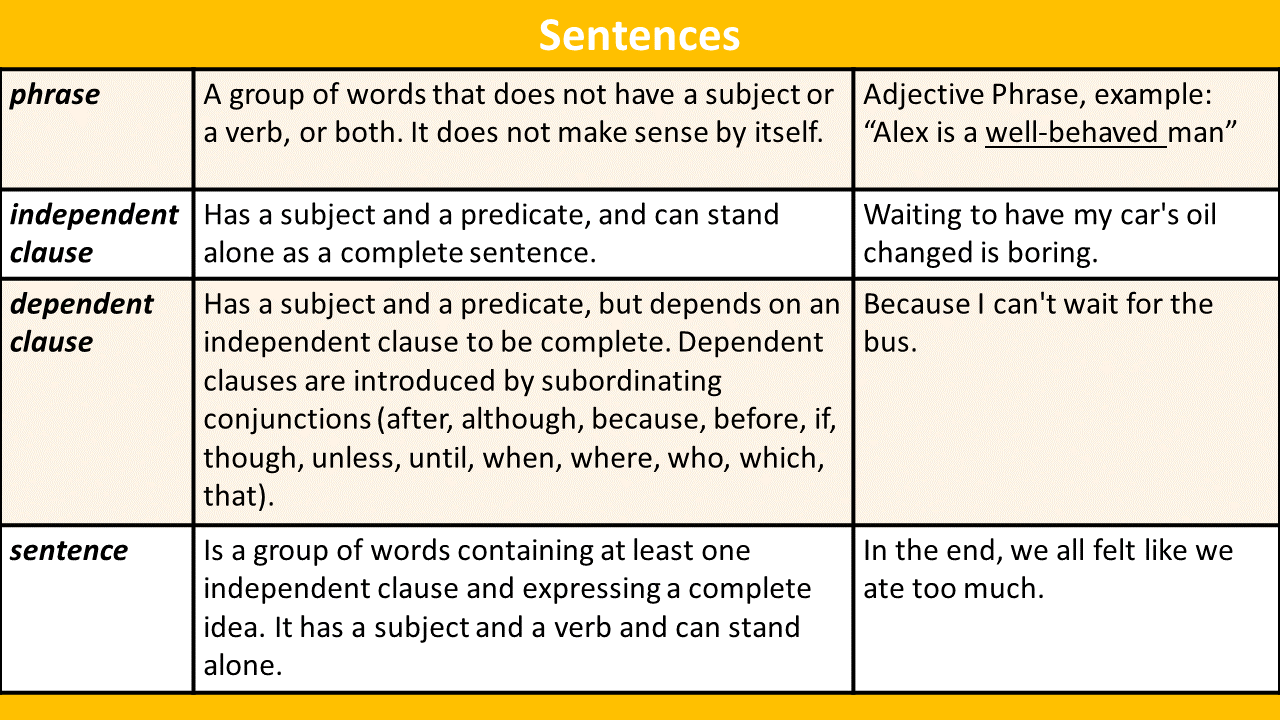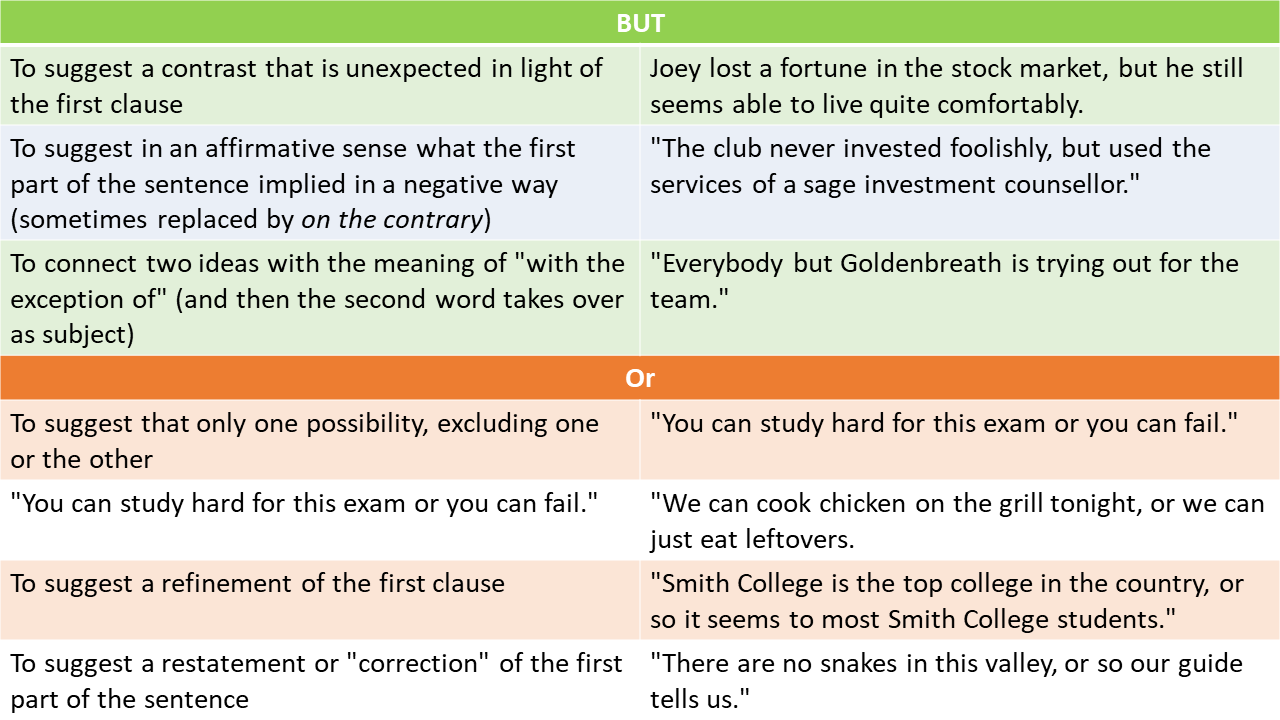Communication would be a great deal easier if we all knew what the other person meant. Often what we want to say can come out completely wrong if we do not show the reader through language conventions what we mean with our message.
By following the basic rules of grammar, punctuation and spelling everyone with whom you communicate will arrive at the same meaning of what is being said.
Sentences
Standard written English require correct sentence structure and punctuation. To understand sentence structure and to recognize and fix problems correctly, you need to know the definitions of a phrase, an independent clause, a dependent clause, and a sentence.

Variety in Sentences
To make your written work more understandable and easier to read, try using a variety of basic sentence structures. We can categorize sentences into four main types, depending on the number and type of clauses they contain:
Simple (one independent clause): We drove from Cape Town to Johannesburg in one day.
Compound (more than one independent clause): We were exhausted, but we arrived in time for my father's birthday party.
Complex (one independent clause and at least one dependent clause): Although he is now 79 years old, he still claims to be 65.
Compound-complex (more than one independent clause and at least one dependent clause): After it was all over, my dad claimed he knew we were planning something, but we think he was really surprised. Sentences have to be combined to avoid the monotony that would result if all sentences were short and of equal length.
Compounding Sentences
A compound sentence consists of two or more independent clauses. That means that there are at least two units of thought within the sentence, either one of which can stand by itself as its own sentence. The clauses of a compound sentence are either separated by a semicolon (relatively rare) or connected by a coordinating conjunction (which is, more often than not, preceded by a comma). Two of the most common coordinating conjunctions are and and but. (The others are or, for, yet, and so.) This is the simplest technique we have for combining ideas:
Meriwether Lewis is famous for his expedition into the territory of the Louisiana wilds, but few people know of his contributions to natural science.
Lewis had been well trained by scientists in Philadelphia prior to his expedition, and he was a curious man by nature.
Compounding Sentence Elements
Within a sentence, ideas can be connected by compounding various sentence elements: subjects, verbs, objects or whole predicates, modifiers, etc. Notice that when two such elements of a sentence are compounded with a coordinating conjunction (as opposed to the two independent clauses of a compound sentence), the conjunction is usually adequate and no comma is required.

Subjects: When two or more subjects are doing parallel things, they can often be combined as a compounded subject.
Example: Working together, John Smith and Susan Jones convinced stakeholders to raise money for the expedition.
Verbs: When the subject(s) is/are doing two things at once, ideas can sometimes be combined by compounding verbs and verb forms.
Examples: He studied the biological and natural sciences.
He learned how to categorise and draw animals accurately.
He studied the biological and natural sciences and learned how to categorise and draw animals accurately.
Notice that there is no comma preceding the "and learned" connecting the compounded elements above.
At university, Lewis learned to chart the movement of the stars.
He also learned to analyse their movements with mathematical precision.
At university, Lewis learned to chart and analyse the movement of the stars with mathematical precision.
OR — At university, Lewis learned to chart the stars and analyse their movements with mathematical precision.
Modifiers: Whenever it is appropriate, modifiers such as prepositional phrases can be compounded.
Examples: Lewis and Clark recruited some of their adventurers from bars.
They also used recruits from various military outposts.
Lewis and Clark recruited their adventurers from river-town bars and various military outposts.
Conjunctions: A conjunction is a joiner, a word that connects (conjoins) parts of a sentence. The simple, little conjunctions are called coordinating conjunctions. Remember the acronym FANBOYS: For-And-Nor-But-Or-Yet-So. Be careful of the words then and now; neither is a coordinating conjunction, so what we say about coordinating conjunctions' roles in a sentence and punctuation does not apply to those two words.)
When a coordinating conjunction connects two independent clauses it is often (but not always) accompanied by a comma:
Example: Ulysses wants to study chemistry, but he has had trouble meeting the academic requirements.
When the two independent clauses connected by a coordinating conjunction are nicely balanced or brief, many writers will omit the comma:
Example: Ulysses has a great pass but he isn't quick on his feet.
The comma is always correct when used to separate two independent clauses connected by a coordinating conjunction. A comma is also correct when and is used to attach the last item of a serial list, although many writers (especially in newspapers) will omit that final comma:
Example: Sam spent his holiday studying basic math, writing, and reading comprehension.
When a coordinating conjunction is used to connect all the elements in a series, a comma is not used:
Example: English and Chinese and Spanish are the most widely spoken languages in the world.
A comma is also used with but when expressing a contrast:
Example: This is a useful rule, but difficult to remember.
In most of their other roles as joiners (other than joining independent clauses, that is), coordinating conjunctions can join two sentence elements without the help of a comma.
Nelson Mandela and Walter Sisulu are among the best-known South Africans.
Among the coordinating conjunctions, the most common, of course, are and, but, and or. It might be helpful to explore the uses of these three little words. The examples below by no means exhaust the possible meanings of these conjunctions.
And:

But / Or:

Using Words Effectively
A sentence should contain no unnecessary words, a paragraph no unnecessary sentences, for the same reason that a drawing should have no unnecessary lines and a machine no unnecessary parts.
Avoid saying the same thing twice.
Many uneducated citizens who have never attended school continue to vote for better schools.
A phrase that repeats itself—like "true fact," "twelve noon," "I saw it with my own eyes"—is sometimes called a pleonasm.
Redundant phrases are bad habits just waiting to take control of your writing.
Beware of the following:
|
Redundancy |
The Lean Version |
|
12 midnight |
midnight |
|
12 noon |
noon |
|
3 am in the morning |
3 am |
|
a person who is honest |
an honest person |
|
a total of 14 birds |
14 birds |
|
biography of her life |
biography |
|
circle around |
circle |
|
close proximity |
proximity |
|
completely unanimous |
unanimous |
|
consensus of opinion |
consensus |
|
cooperate together |
cooperate |
|
each and every |
each |
|
enclosed herewith |
enclosed |
|
end result |
result |
|
exactly the same |
the same |
|
final completion |
completion |
|
free gift |
gift |